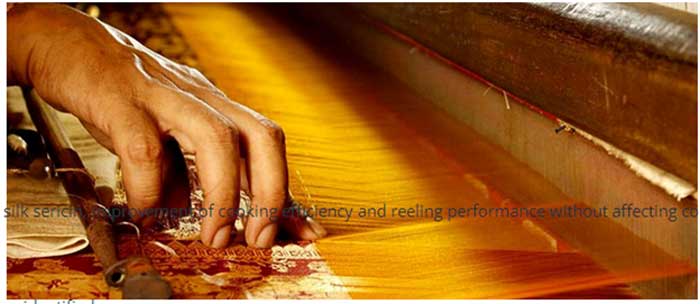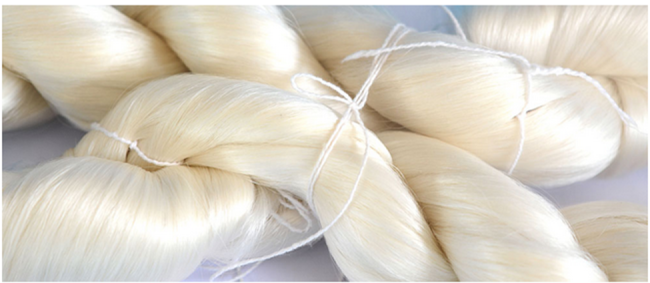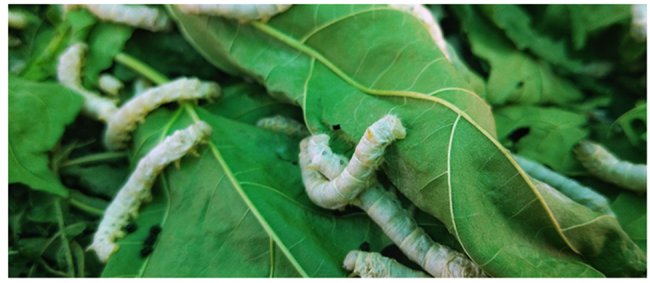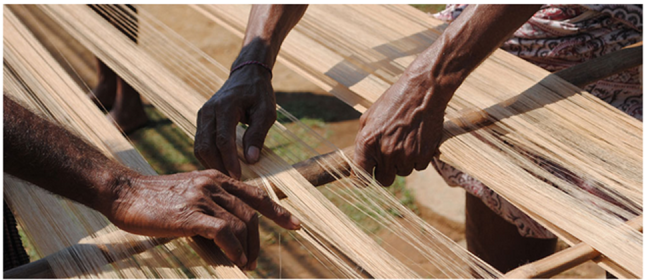
Silk Industry in India: A review of the current scenario
The government policies have favoured the cultivation and development of silk and created labour opportunities.
The article discusses the different aspects of silk production in India. The industry which has received funding from the convergence of various ministries has given sustainable livelihood to farmers, in particular to women of marginalised communities in the states of Jharkhand, Odisha, West Bengal, Chhattisgarh, Maharashtra, Andhra Pradesh, and Bihar by giving them jobs. The Government of India has a special focus on the development of the silk industry in the Northeast States.
Introduction
In Ramanagara, the famous silk town of India about 50 km from Bengaluru, a huge two-storey market building on Mysore–Bengaluru highway is a hive of activity in the morning hours. Known to be Asia’s largest silk cocoon market, here the region’s largest volume of trading of cocoons takes place with sericulturists coming from all over the state and from neighbouring states to get the best deal for their silk cocoons.
This market is part of the office of Deputy Director, Department of Sericulture, Karnataka State government, under whose supervision the auctioning process worth Rs 10 crore takes place every day. About 10,000 sericulturists sell an average of 45,000 kg to 50,000 kg silk cocoons to the silk reelers and intermediaries through e-auctioning and the State earns about Rs 1 lakh by way of tax from the transactions. What used to be a noisy market scene till a few years ago is now a reasonably quiet activity, thanks to the implementation of the State Government’s IT initiative in the industry sector.
Other than a few days of the initial lockdown months, the pace of the activity of farmers and the reelers in the state did not slow down, and after a lull of loss with big drop in cocoon prices business is bouncing back to the original.
Silk production in India
India is the second-largest producer of raw silk in the world after China. The country has a unique distinction of being the only country producing five different types of silks in the world. Mulberry silk is produced predominantly in southern states of Karnataka, Tamil Nadu, Telangana, and non-mulberry varieties (Vanya silk) such as Tussar is produced in Chhattisgarh, Jharkhand, Odisha, and West Bengal. Moga silk is specific to Assam state and Eri silk is grown in Meghalaya and Nagaland. Mulberry silk constitutes nearly 70 per cent of the total silk produced in India with Karnataka leading the production of mulberry silks. Realising the huge employability potential spawning across the value chain of the silk industry, that could put the country on economic growth trajectory, the Government of India established the Central Silk Board (CSB) soon after the country attained Independence, and with it a series of policies. With low capital requirement and remunerative nature of production from rural on-farm and off-farm activities, and an ever growing culture bound domestic market, silk industry has been central to the socio-economic development of large agrarian population, providing employment to 9.4 million people in rural and semi-urban areas.

Unlike seasonal crops, sericulture can be done round the year and harvested as many as 5–6 times a year. With attractive prices for cocoons at ‘550 per kg in present day, sericulturists find it lucrative than growing any other cash crops. An estimated 35,820 MT of raw silk was produced during 2019–20, which fell by almost 30 per cent during the pandemic. Though part of the raw silk demand is met with imports, much of silk exports earnings is from silk garments, silk carpets and silk wastes, which totalled to Rs 1,466 crore in 2020–21.
The industry which has received funding from convergence of various ministries such as the Ministry of Rural development, Ministry of Textiles, and schemes such as Mahatma Gandhi National Rural Employment Guarantee Act (MGNREGA) and Seri-forestry has given sustainable livelihood to farmers, in particular to women of marginalised communities in the states of Jharkhand, Odisha, West Bengal, Chhattisgarh, Maharashtra, Andhra Pradesh and Bihar by way of 36,000 jobs. Around 36,154 farmers including 2497 women farmers were given help to raise 1521 hectares (ha) Tussar plantations in private wastelands. Under Special projects, 14,227 commercial seed rearers produced 2240 lakh of reeling cocoons. Further expansion of programme under the rural livelihood mission will include 35,000 women farmers.
Silk production process
Silk production is done in two phases, pre-cocoon phase and post cocoon phase. In the first phase, sericulturists do mulberry plantation and rear disease free silkworm seeds that are made to grow on mulberry leaves. Great care is taken towards the initial seeds and the mulberry plantation since the quality of silk depends on the leaves that are fed to the silkworms.
Silkworms go through four different stages of growth from eggs to moth and at caterpillar stage spin a cocoon around them. The spun thread excreted by the silk gland of the silkworm consists of primarily two proteins—fibroin, the fibre and sericin, the adhesive between cocoon and the fibre.
Reeling comes in the post cocoon phase. Within fifteen days of cocoon spinning, silk is reeled from the cocoons to obtain best quality silk. One roll of silk can be produced with 10 kg of cocoons. The reeled silk goes to weavers and made into finished products for the consumers’ market.
Since centuries, reeling of silk threads is being done on reeling machines installed at homes of silk industrialists. A simple process of reeling involves cooking the cocoons in hot water and while the cocoons are still hot, the silk fibres are held with fingers and reeled into threads. With the advent of automation in all fronts of the industry, there are now high capacity automated reeling machines with high productivity and yield rate, needing minimum human intervention.
Government schemes across the silk value chain
Silk Samagra, a Central Silk Board’s initiative, is an integrated scheme towards development of sericulture industry in the country that encompasses maintenance of the Basic Silkworm Seed Farms supplying seeds to the States, R&D, training, transfer of technology, IT initiatives, market development, quality testing and certification, export, brand promotion, and upgradation.
Research and development
For value addition and for import substitute to meet domestic demand of this Queen of Textiles, the Government of India in recent years has put emphasis on research and development on multiple fronts, viz., high yielding, climate resilient, higher photosynthetic efficient mulberry varieties, better quality disease resistant silkworms of hybrid and new seed germ, with better cocoon yield, shells with better quality silk filament lengths and less wastage.
The research projects in collaboration with countries such as Bulgaria, Russia, the USA, Japan, Sweden and Australia that use state-of-the-art technology, viz., genetics and molecular characterization techniques have given successful outcomes. Productivity enhancement of mulberry from 50 MT/ha/yr to 62 MT/ha/yr, development of bivoltine (breeding twice a year) and multivoltine varieties (many times a year) of silkworm with targeted traits, improvement of disease free cocoon yield by 1.5 times, identification of viral disease markers and gene markers for hybrid (cross breed) silkworms, understanding of viruses infecting Tussar and humidity tolerance in silkworm, understanding of fibroin for enhanced healing properties are some of the achievements in this regard.

Post cocoon R&D
In post cocoon sector, development of a miniature machinery for Eri spinning, wet reeling of Tussar and Muga, dry reeling for Tussar cocoon, equipment for recycling of silk reeling water, degumming procedure, chemicals with solubility for mulberry silks, measurement of molecular weight of red Eri silk sericin, improvement of cooking efficiency and reeling performance without affecting colour/lustre or tensile properties of silk fibroin, solar cooker and hot air dryer with low power consumption are some of the achievements.
Focus on Northeastern states
The Government of India has special focus on the development of silk industry in the Northeast States, and so a research on soil for varying nutritional capacity and phytochemical diversity in different agro-climatic zone of Meghalaya and Assam was carried out and four different Vanya host plants were identified.
The impact of petroleum crude oil on Muga culture and mitigation measures, different formulations to reclaim soil and mitigate diseases of the host plant, eco-friendly bait for bug predator, solar LED light traps to control pests and predators in Muga ecosystem, diagnostic tool for detection of disease causing virus in Oak Tussar egg, disinfectants for disinfection of silkworm, and preservation and incubation of Muga eggs are some other achievements. Using genetics and data sequencing, a wild silk moth in Nagaland was studied and a whole genome library of Tussar silkworm was developed. The knowledge was used to release five breeds of Vanya silkworms as potential breeds. Besides, a model for prediction of infestation using geospatial technique was developed for alerting farmers to take precautionary measure before disease outbreak.
Thirty-eight projects of Mulberry, Muga and Eri silk worth Rs 1107.90 crore are implemented across the Northeast States with 38,170 acre of plantations to generate employment for 300,000 people and produce additional 2650 MT raw silk. Silk printing and Processing Unit in Tripura targets to print and process 1.50 lakh metre silk per annum. Seed infrastructure units for all the three silk varieties under the CSB have been set up in Assam, Nagaland and Meghalaya and Eri spin silk mills are set up in Assam.
To monitor the project progress geotagging of the details of land, beneficiaries and the assets created is also undertaken.

Silk Industry wastes and their uses
A lot of waste is generated in silk production such as twisted silk, rough silk, unreeled wasted cocoons other than organic wastes from plantations. Plantation wastes as also the silk wastes are found to have remarkable qualities for use in various industries including pharmaceuticals and cosmetics.
Stems of mulberry plants are used for bats, agricultural implement, stem pulp used for paper, stem barks are antirheumatic, hypotensive, diuretic, the branches are used for fuel and for anaerobic composting along with leaves. Mulberry leaves given to cows enhance the milk yield, and if used as tea can control blood pressure. Mulberry root bark agglutinates the blood, kills worms in digestive tract and is used in laxatives and medicines. Mulberry fruits have antidiabetic, antioxidative properties, and fruit juices of mulberry can cure mouth ulcers, fever, beneficial for heart, throat, enhance appetite, eyesight, and helpful in treating anaemia, dizziness, constipations, fatigue, and so on.
The silkworm larvae and pupae, and faeces and their by-products are useful for common ailments. Pupal oil serves good for liver and blood diseases. Pupae contains vitamins B1, B2, and vitamin E; live pupae is used to synthesise antibacterial peptides, and a therapeutic tar obtained from pupae is bactericidal and antihistaminic—superior than plant source, the de-oiled pupae used as fish and poultry feed, and dog biscuits.
Silkworm excreta are organic manure and fish food enhances water holding capacity of soil and destroys harmful pathogens. With cattle dung they produce gobar gas, and used in making acid-resistant plastic sheets. They contain solanesol, which is a precursor for cardiac drugs, and chlorophyll extracted from faeces is used to treat gastric disorders, ulcers, hepatitis, blood and liver diseases. The faeces also contain growth hormone, and their pectin reduces blood triglyceride and blood cholesterol, and phytol is used in medicines and perfumes. The silkworm moths are used for making wine and medicine, poultry feed, soap making, moth oil used as textile dye, and in drugs for curing trauma, and other hormonal disorders.
Pelade, the innermost layer of a reeled cocoon shell, which has a special microstructure and mechanical properties, with protein and amino acids and the next layer chrysalis containing palmitic acid, stearic, oleic, linoleic and eight amino acids, form important ingredients in food and pharmaceuticals.
Fibroin in the silk thread with antibacterial properties is used for tumour treatment and sericin with wound healing properties with less inflammation and collagen regeneration is used for surgical sutures and in skin, hair and nail cosmetics. It is also used in anti-aging and anti-wrinkle creams and ointments. Cocoon shells make decorative and artistic handicrafts.

IT initiatives
The CSB’s initiatives towards the direct benefit transfer for sericulturists and other stakeholders incudes the linking of MIS portal with the DBT Bharath portal. mKisan web portal educates farmers through their mobile phones and SMS service through mobile keeps them updated about market rates of silk and cocoons. The CSB website has a national database of 737,881 farmers, and reelers for benefit of policymakers and for common citizens and for nodal officers to interact with the farmers on mobile phones.
Silks Portal, a knowledge system portal for the Northeastern States has been developed in association with North Eastern Space Application Centre, by capturing geographical images and for further analysis and selection of potential areas for promoting sericulture activities. The MIS contains database about intensive bivoltine sericulture project in the states. The MIS is also developed for fund management, communication, automatic reeling machine data collection, and an integrated system for CSB’s internal activities.
Training
The CSB has robust training programmes across four sub sectors of silk value chain. Particular emphasis is on the most critical aspect of the entire silkworm seed sector. Silk resource centres set up as training cum facilitation centres in some Mulberry and Vanya clusters establish the link between research and beneficiaries in terms of skill enhancement and problem resolution.
Through training programmes for skill development, entrepreneurship development, lab-to-land demonstration, workshops, skills exposure visits, and Krishi melas every year, nearly 15,000 farmers are trained in different subsectors of sericulture. Extension communications programmes in pre-cocoon and post-cocoon sector have so far benefitted 8024 stakeholders.

Market development
As policy initiative to protect local silk reelers and sericulturists, and encourage exports, customs duty on imports of raw silks was raised from 10 per cent to 15 per cent and anti-dumping duty imposed on Chinese mulberry raw silk of 3A Grade. Quality Certification System includes Cocoon and Raw silk testing units and silk mark promotion. Silk Mark Expos popularise Silk Mark and bring manufacturers and consumers under one platform. Pre-shipment inspection of silk goods meant for export ensures quality of silk goods exported.
Silk weavers get outlet for sale of silk products under the Atmanirbhar Bharat scheme. New fabric design and engineering, revival of traditional silk and new silk blends, product diversification, innovative designs, generating market information, and brand promotion are meant to benefit all stakeholders.
During the pandemic when no Expos could be held, the government partnered with e-platforms such as Amazon and Flipkart for online promotion of 100 per cent pure silk with Silk Mark.
Conclusion and futuristic outlook
The government policies have favoured the cultivation and development of silk and created labour opportunities. India enjoys the top position in silk production only next to china in the world. Special thrust is being given to R&D by way of collaborative projects with a number of countries. Northeastern states have received special attention by the Government. Efforts have been taken to improve the quality of eri, muga and tussar silk varieties. Waste generated from silk production has been diverted to pharmaceutical and cosmetic applications. Government initiatives have been intended to help sericulturalists and stake holders through linking of portals from select websites. Silk resource centres set up as training cum facilitation centres in some Mulberry and Vanya clusters establish the link between research and beneficiaries in terms of skill enhancement and problem resolution. As policy initiative to protect local silk reelers and sericulturists, and encourage exports, customs duty on imports of raw silks was raised from 10 per cent to 15 per cent and anti-dumping duty imposed on Chinese mulberry raw silk of 3A Grade.
References
- N Gokarneshan, Advances in silk research, Woodhead publishing ltd, New Delhi, 2017.
- R.Anitha, Status of silk industry in India, Kisan world, Volume 38, No.2, February 2011.
- Indian Silk Industry, Fibre2Fashion, 2005
- Silk Industry and Export in India, 2023.
- L.A.Khan, How research and advanced technology helped India boost raw silk production, HINDU, November 10, 2023.
- D.Bharathi, Sericulture Industry in India – A source of employment generation, International journal of advanced engineering research and science, October 2016.
- SV Divya, M Murugaswari & R Raghadevi, Export Scenario of silk industry in India, May 2020, Paripex – Indian Journal of Research, Volume 9, Issue 5.
- www.csb.gov.in
- www.tradestat.commerce.gov.in
- A Popeseu, 2018, Considerations upon the trends in the world silk trade, Scientific papers series management, economic engineering in Agriculture and rural development, Colume 18, Issue 1.
- N Gokarneshan, Silk winding scenario in India, Textile Magazine, 2002.
About the authors:
Dr N Gokarneshan, A Jothimanikandan, P Periyasamy, M Ponmaniselvam and K Sridhar, are from the Department of Textile Chemistry, SSM College of Engineering, Komarapalayam, Tamil Nadu.




